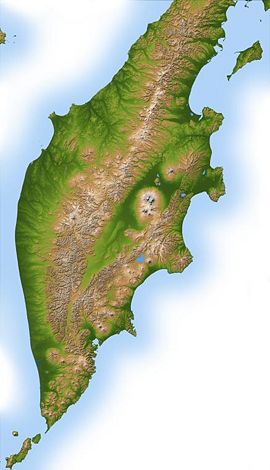Kamchatka Peninsula
The Kamchatka Peninsula is a long body of land jutting dramatically from Russia's and Asia[s northeastern tip, with a length of 1,250 km and an area of 472,300 km². It hangs off eastern Siberia along a general north-south axis, Florida-like, between the Bering Sea to the east and the Sea of Okhotsk to the west, each an arm of the Pacific Ocean. About the size of California as well as neighboring Japan, it is one of the largest peninsulas in the world. Its shape has also been compared to a giant fish, with the head at the south. The peninsula's isolation, beauty, and abundance of wildlife make it a very likely long-term candidate for future tourism development, particularly for an environmentally minded and adventurous clientele.
Geography
Where the Kamchatka Peninsula connects at its northern extreme to the rest of Russia is onlz about 400 km south of the ççArctic Circle@@ REDO - The longest river is the Kamchatka River, running 700 kilometres from south to north
The central valley and the Kamchatka River are flanked by large volcanic ranges, containing more than 160 volcanos, 29 of them still active. Thus, the peninsula has the highest density of volcanos and associated volcanic phenomena in the world, 19 active volcanos being inscribed by the UNESCO on the World Heritage List. it lies on the Great Pacific “ring of fire”.
Most inhabitants live in the regional capital, Petropavlovsk-Kamchatsky (named for saints Peter and Paul), but a traditional way of life can still be seen in the peninsula's many scattered fishing and mining villages.
The highest of these is Klyuchevskaya Sopka (4750 m), while the most striking is Kronotsky, whose perfect cone has been termed the world's most beautiful volcano. Somewhat more accessible are the 3 volcanoes visible from Petropavlovsk-Kamchatsky: Koryaksky, Avachinsky, and Kozelsky. In the center of Kamchatka is Eurasia's only Geyser Valley. "The Land of Fire and Ice"
The Kuril island chain runs from southern tip of the peninsula to a short distance from Japan's northern Hokkaido island. The Aleutian Islands stretch ?thousands of miles? from southern Alaska arcing toward Asia. The westernmmost islands in the chain are Russian territory, not American, and lie about 200 km distant from the middle coast of the Kamchatka Peninsula. Between the peninsula and the Bering Sea runs the Kuril-Kamchatka Trench, with a depth of 10,500 m, similar to the trench that parallels the southern side of the Aleutian chain.
Kamchatka's wildlife includes brown bears, snow ram, sable, wolverine, golden eagle, and gyrfalcon. The peninsula is the breeding ground for Stellar's sea eagle, the largest eagle on Earth. The largest animals in the world, blue whales, are abundant near the coastline. REDO - The South Kamchatka Sanctuary, was first noted for protection in 1882 to preserve the region's sea otter population. Currently about 2 thousand sea otters live along this portion of Kamchatka's shoreline.
Called one of the last untouched places on earth.
Kamchatka has the largest brown bear population in the world - population estimates range from 7,500 to 12,000.
The peninsula is thought to include the world's greatest diversity of salmonid fish. Accordingly, the Kurilsky lake is recognized as the biggest spawning-ground for salmons in Eurasia. Also many varieties of trout.
History
The Kamchatka Peninsula is a part of the Russian Kamchatka Oblast (along with a part of the continent, the Komandorskiye Islands and Karaginsky Island). The majority of the 402,500 population is Russian, and the largest minority is Koryaks. The northern part of the peninsula is occupied by the Koryakia Autonomous District, where around 13,000 Koryaks live. very sparsely populated, averaging less than 1 person per square kilometer.
In the 1680s the first Russian maps appeared showing Kamchatka as a peninsula. By 1743, following Vitus Bering's expeditions to eastern Russia and Alaska, cartographic accuracy had improved to the point that the peninsula's distinct shape was being drawn reasonably correctly.
During the Cold War, the Soviets tested the range and reliability of their missiles by launching them from standard sites, using Kamchatka Peninsula as the target area.
REPHRASE - In the Soviet-period there were several military stations on the peninsula, preventing all foreigners and even most Soviet people from visiting the place. It was not until the 1990s that Kamchatka started opening their doors for tourism. great contrasts -snow vs. heat, glaciers vs. lovely vegetation, the Pacific Ocean vs. the clear sky. still large military presence, source of some pollution.
In early August 2005, the Priz class AS-28 Deep Submergence Rescue Vehicle of the Russian Navy was disabled in a submarine accident near Kamchatka and sunk to the seafloor, requiring an international effort to rescue the crew.
See also
- Kamchatka earthquakes
External links
Credits
New World Encyclopedia writers and editors rewrote and completed the Wikipedia article in accordance with New World Encyclopedia standards. This article abides by terms of the Creative Commons CC-by-sa 3.0 License (CC-by-sa), which may be used and disseminated with proper attribution. Credit is due under the terms of this license that can reference both the New World Encyclopedia contributors and the selfless volunteer contributors of the Wikimedia Foundation. To cite this article click here for a list of acceptable citing formats.The history of earlier contributions by wikipedians is accessible to researchers here:
The history of this article since it was imported to New World Encyclopedia:
Note: Some restrictions may apply to use of individual images which are separately licensed.
